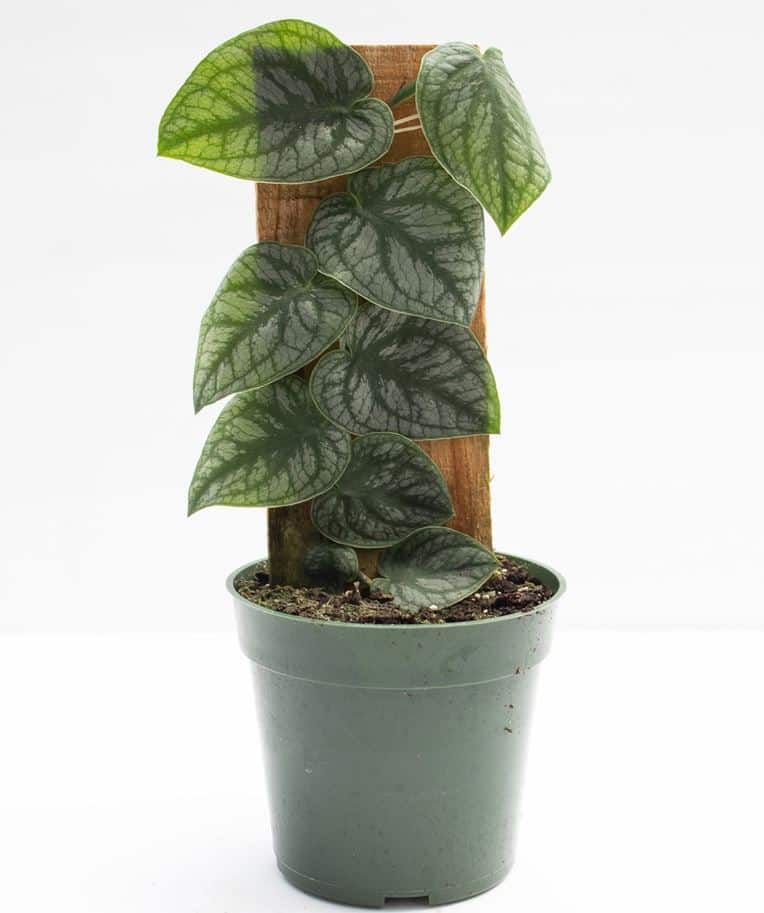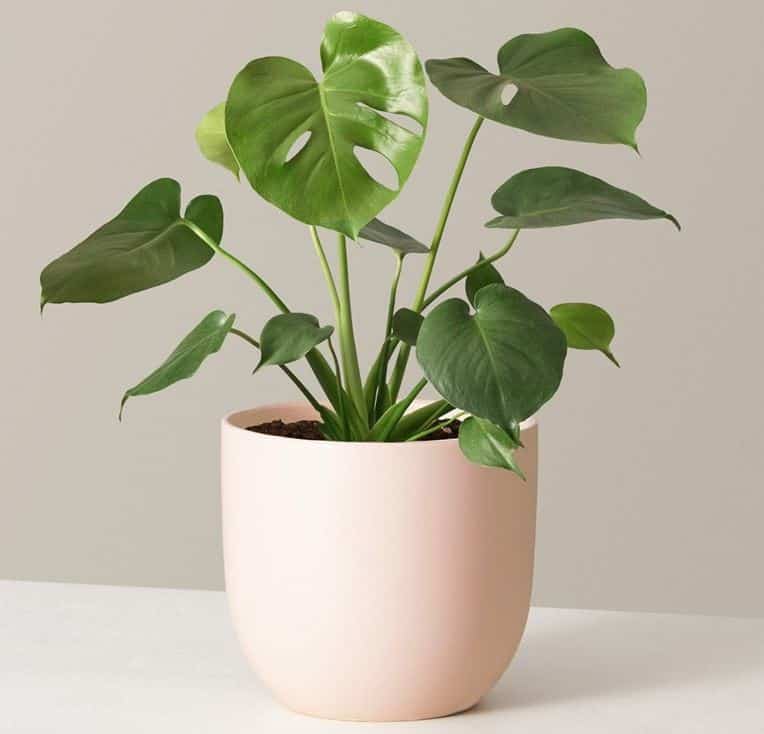The juvenile or a young Monstera happens after the seedling stage, and it lasts until the plant fully matures and begins flowering. It includes the creeping and the early climbing stage when the plant grows larger leaves that may have holes or splits.
We have insight on juvenile young Monstera's growing habits and appearance. You will also learn about their care and growth needs, including young Monstera deliciosa, adansonii, obliqua, or siltepecana.
Contents
- Juvenile or young Monstera growing habits and appearance
- 1. Shingling juvenile Monstera
- 2. non-distinctive juvenile stage
- Young Monstera care
- 1. USDA hardiness zone
- 2. Temperature
- 3. Humidity
- 4. Light
- 5. Soil
- 6. Watering
- 7. Fertilizer
- 8. Pruning
- 9. Repotting
- 10. Support
- Pests and diseases
- 1. Pests
- 2. Diseases
- Problems and possible causes
Juvenile or young Monstera growing habits and appearance
Monstera species are hemiepiphyte, i.e., they grow both on the ground or as a terrestrial plant and on other plants as an epiphyte. And in the juvenile stage, they grow as terrestrial creepers or climbers.

As ground creepers, juvenile Monstera will grow roots on the nodes. As the plant begins climbing and goes beyond a meter, root dimorphism occurs, i.e., they will do the anchoring role and absorb nutrients and moisture from the air.
Like in the juvenile stage, you will have two morphologies, i.e., shingling plants and those that gradually increase in leaf size and stem diameter until they transform to the adult stage.
1. Shingling juvenile Monstera
Seedlings growing as stolons, i.e., from the Monstera section Marcgraviopsis–Monstera dubia, M. acuminata, and M. spruceana or Echinospadix section - M. tuberculate - shingle. So, they are distinctive from the seedling and juvenile stage.

These plants will only start growing leaves when they find a climbing place. At this time, they have stems 3/64 to 5/64 (1-2mm), and their internodes will be longer.
One unique thing about these plants is shingling behavior, i.e., they produce leaves that lie flat on the climbing tree or surface, i.e.., appressed. These asymmetrical leaves have short petioles and overlap, covering stems completely. So, resemble roofing shingles, hence the name, shingling plants.
That is not all. The leaves are vaginate, and the sheathing portion that protects the leaves as they emerge extends to their ligule outgrowth.
Many theories explain the shingling behavior to protect adventitious roots from drying or as an adaptation to help conserve water.
How does shingling help conserve water? Leaves have stomata on their underside. When appressed against the climbing surface, they will protect the leaf underside from wind that will strip away from moisture.
How can you support this theory? Comparing them with those with distinctive juvenile stages, i.e., section Monstera and Tornelia, they have thinner stems and less adventitious roots (aerial). So, it means they cannot collect a lot of water.
Last but not least, there are other plants in the Monsterinae subtribe that also shingle, i.e., Rhaphidophora hayi, cryptantha, and korthalsii.
2. non-distinctive juvenile stage
Plants in Tornelia (Monstera deliciosa) and Monstera sections don’t have distinctive juvenile and seedling stages. Instead, they slowly increase leaf size and stem diameter until they transform to the adult stage.

Members of the section Monstera include:
- M. adansonii
- Monstera acacoyaguensis
- M. adansonii var. laniata
- M. siltepecana
- Monstera. epipremnoides
- M. lechleriana
- M. subpinnata
- Monstera. pinnatipartita
- M. obliqua
- M. standleyana
Plants with non-distinctive juvenile stages are also ground creepers and climbers. Their stems are 5/32 to 25/64 inches (5-10mm) in diameter when they begin growing. Also, they will have many nodes and each has aerial roots if they grow horizontally.
Young Monstera care
It is easy to care for your juvenile or young Monstera. Their care needs and growth requirement are more or less like adult plants.
Here is how to care for your juvenile Monstera:
1. USDA hardiness zone
Monstera USDA hardiness zone is 10b to 12. Frost and freezing temperatures will damage cause damage. Only people in these zones can grow their juvenile Monstera outdoor.
2. Temperature
Maintain a 65 to 85 degrees Fahrenheit (18 to 29°C) temperature for best growth. Lower temperatures will slow your Monstera growth rate. And at 50°F (10 °C), your plant will stop growing.
The other things to avoid are:
- Sudden temperature change (stresses plants as they need time to adjust).
- Cold drafts
- Heat stress and placing plants near heat-emitting appliances or vents.
3. Humidity
As tropical rainforest plants, Monstera needs average to above average humidity. Give them at least 50% or more. Otherwise, leaves will curl, have brown tips and edges (leaf scorch), fall, and your plant may look droopy or limp.
If your house has low humidity, and mist plants a few times a week, move them to the bathroom, kitchen, or rooms with higher moisture or use a pebble tray. If you have several plants, put them together to create a microclimate.
A more sure way is buying a humidifier. If you need one, we have a very good experience with LEVOIT Humidifiers Top Fill, 6 Liter, Cool Mist. Many users have also rated it well and it humidifies a large area of 505 sq. ft. What we like most is the running time which is as much as 60 hours. Did you know you can control it Vesync APP and connect it with other third-party voice assistants?
4. Light
Like adult plants, the juvenile Monstera need bright, indirect light. But they don’t mind medium to low. If you have a variegated Monstera, stick to bright, indirect light.
Too little light will make the plant leggy, grow slowly, and have pale or yellow leaves. Also, leaves may fall, among other issues.
On the other hand, direct sun will cause sunburn. You will see crispy brown margins and tips, yellow leaves, and a washed-out or bleached plant, among other signs.
5. Soil
Your Monstera needs well-draining and airy soil high in organic matter. The ideal pH is 5.5-7.5 (slightly acidic to neutral). An aroid mix (see Etsy.com) or even a soil-less mix is still perfect.
A good mix can haven30% potting soil, 30% sphagnum moss, and 30% perlite. For the rest, you can add worm castings and bark chips.
6. Watering
Water your young Monstera when the potting mix’s top 1-2 inches feel dry. It may be once a week in spring and summer and biweekly in winter and fall. How often to water your Monstera depends on your conditions and will vary. Don’t follow a schedule.
One way to know your plant needs watering is by using a soil moisture meter. I use XLUX and water when the reading is three or less. This meter is accurate, responds fast, and is affordable. Also, it doesn't need batteries.
Slowly saturate the soil until water flows out of the potting mix when watering. Discard any water that collects on the saucer.
Remember that these plants require moist soil, not soggy or too dry. Let the soil slightly dry in-between watering. Overwatering will cause root rot.
7. Fertilizer
Feed them once a month with an all-purpose balanced liquid houseplant fertilizer in spring and summer. Don’t fertilize your plants in the non-growing season. Also, don’t feed for at last six weeks after repotting.
The balanced, NPK 1-1-1 Miracle-Gro Indoor Plant Food (Liquid) will not let you down. One pump should be enough. However, for larger pots, use two pumps or mix and add 4 pumps to a quart of water. Apply it once or twice a week since it's so dilute.
However, if you are using a more concentrated brand like Bonide 10-10-10 Liquid Plant Food, use ⅛ per quart ONCE A MONTH. You can start with half this concentration.
8. Pruning
Since they are still young, pruning will involve cutting any dead, damaged, or diseased leaves with sterilized pruning scissors. Don’t prune branches or stems yet.
9. Repotting
Young Monstera requires repotting yearly. Use a pot, 2-3 inches wider in diameter and repot preferably in spring. But summer is still ok.
10. Support
If you want your young Monstera to grow large split and fenestrated leaves, you need to give it a place to climb. Not to overemphasis, some species with stolon-like seedlings need a place to climb to grow leaves. And the shingling ones like M. acuminata and M. dubia will look incredible on a
Your baby plants don’t yet need a very tall moss pole. You can start with Moss Pole - 2 Coco Coir Poles Extending to 28.7 Inches and use a Velcro Brand gardening tape (the best in the market) to mount it.
However, you can also use a burlap-wrapped bamboo or cedar pole. A trellis is also a good pick. Instead of velcro gardening tape, twist ties, or a soft string to train these plants in their stake.
Pests and diseases
If grown indoors, your juvenile Monstera are unlikely to end up with pests or even disease. But they may occur.
1. Pests
Common pests that may attack your young Monstera include thrips, scale, mealybugs, whiteflies, or spider mites. Infestation signs include black, brown, or yellow spots and visible small bumps, dots, or winged insects that may move, leap, or not.
More signs are silvery stippling, honeydew, sooty mold, holes, deformed leaves, and so on. The signs will depend on the bug present.
Use horticultural oil sprays, neem oil, and insecticidal soap to control pests. For minor cases, hose the plant to dislodge the pests.
Last but not least, if your potting is always moist and you overwater your Monstera, you may notice fungus gnats too. Their larvae feed on roots causing yellow leaves, sudden wilting, or even death.
To control and manage gnats, let the soil dry in-between watering and ensure you have a well-draining mix. You can also use sticky traps, Pyrethrins, among other ways.
2. Diseases
Fungal and bacterial leaf spots, rusts or blights, and Monstera root rot are the most likely disease you will notice. Also, your plant may have Monstera mosaic disease, but it is uncommon.
Practice good sanitation (washing hands before touching plants and sterilizing gardening equipment) and avoid water splashing on leaves. Also, inspect new plants to ensure they are disease-free.
The bacterial disease has no cure. Discard affects plants. For fungal ones, consider a fungicide.
Problems and possible causes
As you care for your young Monstera, you may encounter some issues or problems. Here are the common ones and their possible causes.
| Problem | Likely cause | Other possible causes |
| Leaves turning yellow | Overwatering and too little light are the most common causes. | Too much light, nutritional deficiencies, overfeeding, transplant shock, rootbound plant, underwatering, pests, and diseases |
| Leaves curling | Underwatering, low humidity, too much light or heat stress | Pests, transplant or repotting shock, cold drafts, rootbound, and overwatering |
| Drooping or wilting | Underwatering, too much light or heat stress, low humidity, | Overwatering, disease, pests, overfeeding, rootbound, and transplant shock |
| Brown leaves, tips and edges | Underwatering, too much light, low humidity, or heat stress, overfeeding, | Overfeeding, cold drafts, aging, transplant shock, or water quality |
| Brown spots | Pests and disease | Overwatering or fertilizer burns |





Leave a Reply